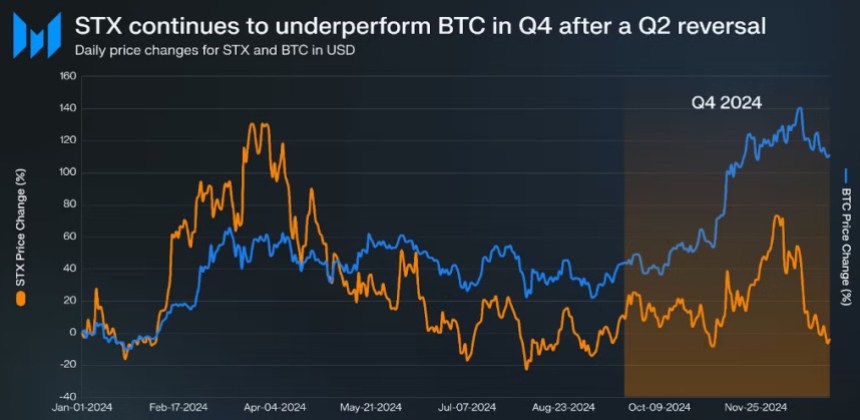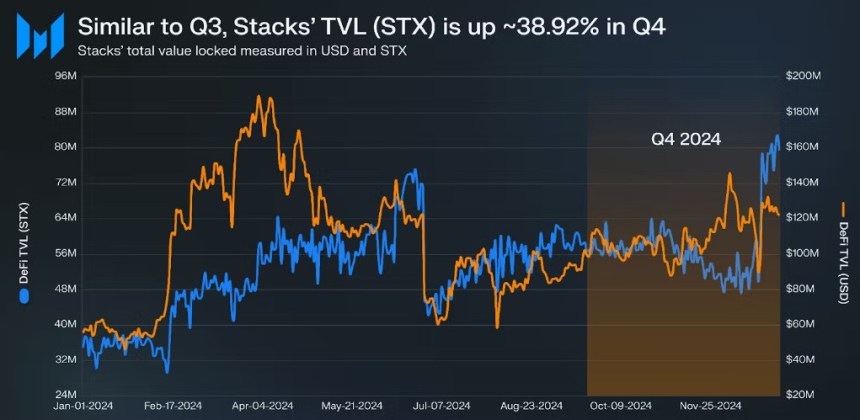Reason to trust

How Our News is Made
Strict editorial policy that focuses on accuracy, relevance, and impartiality
Ad discliamer
Morbi pretium leo et nisl aliquam mollis. Quisque arcu lorem, ultricies quis pellentesque nec, ullamcorper eu odio.
In a recent report by market intelligence firm Messari, open-source blockchain network Stacks (STX), demonstrated a complex performance landscape in the fourth quarter of 2024.
Revenue Recovery For Stacks: Q4 Sees 85% Surge
While Bitcoin (BTC) and Ethereum (ETH) experienced significant growth—approximately 48% and 28% quarter-over-quarter (QoQ) respectively—Stacks faced a decline of 9.5%, dropping its market cap from $2.75 billion to $2.31 billion.
This downturn also saw Stacks’ market capitalization rank fall from the 43th to 51th position, reflecting a weakening position within the broader cryptocurrency market.
STX’s price similarly mirrored this decline, decreasing about 16.8% QoQ from $1.84 to $1.53. However, on a year-over-year (YoY) basis, Stacks has shown resilience, with prices and market cap up approximately 2.23% and 7.74% respectively.
As a layer-2 (L2) solution for Bitcoin, Stacks is intricately linked to Bitcoin’s performance. Early in 2024, STX diverged from BTC’s price trends, achieving a growth of around 130.06%, compared to Bitcoin’s 61.45%.
However, this momentum reversed in the latter half of the year, as BTC surged to 111.35% year-to-date (YTD) while STX fell into negative territory, down 3.48% YTD by the end of Q4.

Despite these challenges, Stacks observed a notable recovery in revenue during Q4, rebounding after declines in the previous two quarters.
Total revenue surged approximately 85.83% in native STX terms, reaching around 260,252 STX, and increased about 117.95% in USD terms to approximately $510,824.
According to Messari, this recovery was likely fueled by the successful Nakamoto upgrade on October 28, 2024, which triggered a spike in revenue the following day.
User Engagement Soars
Accompanying this revenue boost was a rise in network activity, with average daily transactions increasing by approximately 27.36% QoQ, from 7,938 to 10,110. However, it’s noteworthy that these figures remain about 23.41% lower than in Q4 2023.
Meanwhile, average daily active addresses rose significantly by 62.47% QoQ, demonstrating a resurgence in user engagement, with a YoY increase of 72.29%.
The total value locked (TVL) in Stacks continued its upward trend, increasing approximately 15.59% QoQ and 121.88% YoY in USD terms. In native STX, TVL rose about 38.93% QoQ, indicating a strengthening ecosystem with growing participation.

Similarly, the average daily Stackers saw a modest increase of 3.40% QoQ, but their numbers remain significantly lower YoY, suggesting ongoing challenges in staking engagement.
This decline in Stacker participation limits the amount of STX locked in the network, thereby reducing the influence of staking on miner competition and overall Proof-of-Transfer (PoX) efficiency.
The average daily net burn in USD increased 8.34% QoQ, suggesting heightened competition among miners seeking block rewards. Despite this, the average daily net stack metric showed a decline of 21.76% QoQ, indicating fewer Stackers were actively supporting network security.
Interestingly, average daily net rewards in USD saw substantial growth, rising 32.48% QoQ to approximately $3.32 million. Although BTC-based rewards saw a slight decrease, they remained significantly higher than the previous year, reflecting that active miners and Stackers are capturing larger shares of the rewards pool.
Featured image from DALL-E, chart from TradingView.com




















